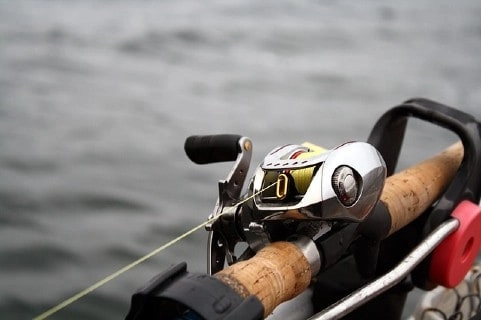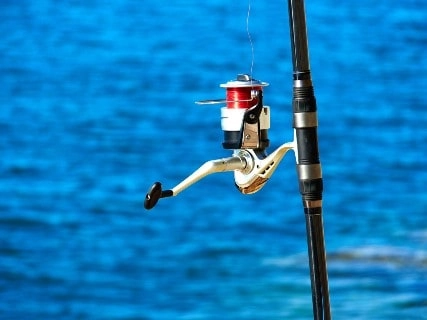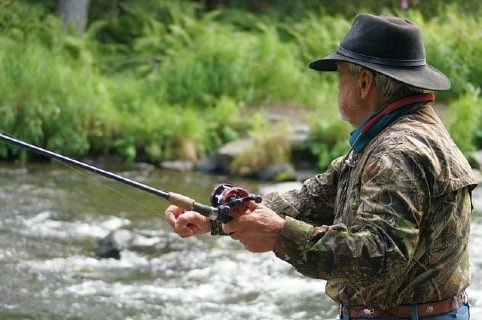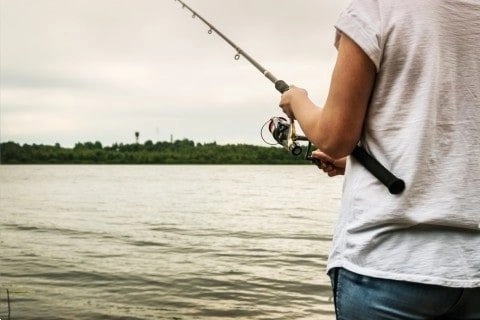Fishing has been a recreational and competitive activity for years so you’d think that buying the right kind of equipment is a piece of cake. However, it has been frustrating for a number of individuals, and for decades you couldn’t choose between a right hand reel vs left hand reel.
Originally, baitcaster rods had the reel on the right-hand side, while spinning rods featured a left-handed crank. As a result, a right-handed individual needed to switch hands after casting with a baitcaster. As this didn’t take into account their dominant hand, switching impacted the efficiency of their cast. At the same time, those new to fishing and using a spinning reel had to get used to cranking with their left hand even if they were right-handed.
Table of Contents
Difference Between a Baitcaster and a Spinning Reel
Further information is required to gain a better understanding of the importance of right-hand and left-hand reels. A baitcaster has a reel that sits on top and parallel to the rod. The line is released directly from the spool at the same angle as the rod. You then usually switch to holding it with your other hand while you reel it in with your dominant hand. Overall, a baitcaster is used for reeling in heavy fish in difficult, weedy areas.
Conversely, a spinning reel is very good for beginners. The spool is mounted on the bottom of the rod for better balance. When casting, the line is released away from the rod and retrieved without switching hands.
What Hand Do you Hold a Fishing Rod in?
The answer related to the hand you use to hold a fishing rod seems simple. You carry it in your dominant appendage, right. However, this has been subject to debate since baitcasters and spinning reels were invented.
The go-to answer is that you use your dominant hand when you cast either the baitcaster or a spinning reel. Yes, the individual who regularly uses this hand has better control and, in turn, accuracy when casting. Still, it’s the construction of the reel that causes confusion with the identification of handedness in a fishing rod.
Why are Baitcasters Right Hand Retrieve?

With a baitcaster, you need to use your thumb on the spool to control the line. Once your cast is complete, then you can switch so the reel sits in your left palm to hold up the reel and you can crank with your right hand. You don’t actually hold the rod while you fish.
Decades ago, it wasn’t like you couldn’t fish left-handed. It was just that you didn’t have a choice with where the reel was located, so while it was easier to choose a rod no matter which was your dominant hand, some people found the sport easier than others. These days, left-handed anglers can buy a baitcaster to cast with their left hand and then switch to crank with their left hand too.
Of course, it takes practice to achieve a smoothness. It’s not much different than passing a baseball from your gloved catching hand into your throwing hand. The same thing goes for juggling. You quickly transfer objects between your hands to maintain a smooth momentum. With enough practice, these movements become natural.
Why are Spinning Reels Left Handed?

It works differently when casting with a spinning reel rod. You place a finger on the line to control it. Since you’re already holding the rod with the foot stem (which links the body to the handle) connected to the reel, it’s awkward to switch it to your left hand. That’s why most people cast a spinning reel with their dominant hand and retrieve with the other hand.
There are other advantages to using your non-dominant hand to crank the handle of a spinning reel if you cast with your dominant one. Case in point, since you don’t switch hands after the cast, you minimize the risk of backlash. This is a condition where the lure slows down as the line keeps going. The result is a tangle commonly known as a bird’s nest.
Another advantage of not switching hands is rapid retrieval. When you work with top-water baits, you could start reeling in your line as soon as the lure hits the water.
While these methods are practiced the most, they aren’t etched in stone. Anglers can cast with either hand. They can use spinning reels in their right hand and the opposite when it comes to baitcasters. In other words, they do what feels most comfortable or what they’ve done over years of experience.
The weight of fishing gear is also a factor. Spinning reel lines are somewhat lighter in both rod and line. Many veteran anglers hold the rod in their dominant hand to establish better control. Since the handle faces less resistance during retrieval, it’s not that difficult to master reeling it in with the non-dominant hand. This allows them to act quickly when they feel subtle bites.
Conversely, baitcasters have a heavier line and tackle to handle bigger fish. Though it’s recommended to start a cast with your right hand, most experienced individuals will then switch hands and use their dominant one to crank, establish control and minimize the line’s feed.
In the end, use your best judgment to determine the best way to hold your baitcaster or spinning reel.
What is a Right Handed Vs Left Handed Fishing Reel?
Generally, a left-handed reel is one where you turn the spool crank with the left hand and a right-handed reel is cranked with the right hand. This means that if you’re a lefty, you would probably want a left-handed baitcaster or set up a spinning reel so that you hold the rod in your left hand and crank with your right.
Are There Left Handed Fishing Rods?
Although unheard of a half-century ago, left-handed baitcasters recently became available on the market. These are great for right-handers who don’t want to switch hands after casting or for left-handers who do.
Spinning reels already have an option to switch the crank from one side to another and are therefore not sold as either “left-handed” or “right-handed”. You just need to buy or borrow any good one and change the hand crank from one side to the other if needed. We can show you how to switch a reel from left to right handed retrieve on a spinning reel.
Can you Switch the Handle on a Baitcaster?
No, you can’t change the handle on a baitcaster from the right to the left or vice versa. If you’re a left-handed angler you’re in luck living in these times because you can just buy a left-handed baitcasting reel with the handle on the left and be just as efficient as a right-handed angler.
How to Hold a Fishing Rod Left Handed

There are several ways to hold a fishing rod in your left hand. It depends on your experience level. Follow these instructions for beginners:
1. Locate the center of balance
A fishing rod isn’t evenly proportioned. The front end, where the line is cast, is considerably lighter than the rod’s base where the spool exists. When you aren’t able to find the right balance, your line goes askew or you drop the equipment.
Finding the balance does two things. It offers comfort – something described below – and provides a good guy line for you to place your pointer finger.
2. Find a comfortable stance for a perfect grip
Fishing isn’t a quick pastime. It requires a great deal of patience, and this means holding the rod and reel for a long time. So, you want your casting hand in the proper location. This means placing the pinky of your left hand under the reel stem. This is the elongated section that starts at the reel’s foot and continues into its frame.
3. Grab the fishing rod

If you’ve secured your pinky around the stem, then grab the fishing rod itself with the remaining three fingers. They need to face the pole while your thumb is placed behind the reel. This reduces the risk of dropping the pole. Additionally, it provides you with the proper leverage to bring in a powerful fish.
4. Angle the rod
As soon as you make your cast, place the rod against your left arm. If offers better control to rapidly respond to a bite.
Instructions for Left-hand Fishing
If you utilize your left hand more than your right, then you’ll probably feel more comfortable fishing with the dominant appendage. It increases your confidence in both baitcasters and spinning reels. Furthermore, you feel in control when casting and retrieving your lure or a catch.
The easiest way to operate a left-handed spinning reel is to hold it between your fingers. With a baitcaster, you need to place the webbing of your left hand under the rod. Then, lie your thumb on top of the reel and press the button to release the line. If the lure drops on top of the water, then you can keep the fishing rod in your left hand.
If it’s a baitcaster, you could also move it to your right. If it’s a spinning reel, however, you risk losing some control. Plus, releasing your thumb from the spool could cause backlash.
If you decide to keep the fishing rod in your left hand, then use your right hand to reel in the lure and cast again with your left hand. Don’t switch it up if you land a fish immediately. You’ll need the strength of your dominant hand to bring in your catch.
